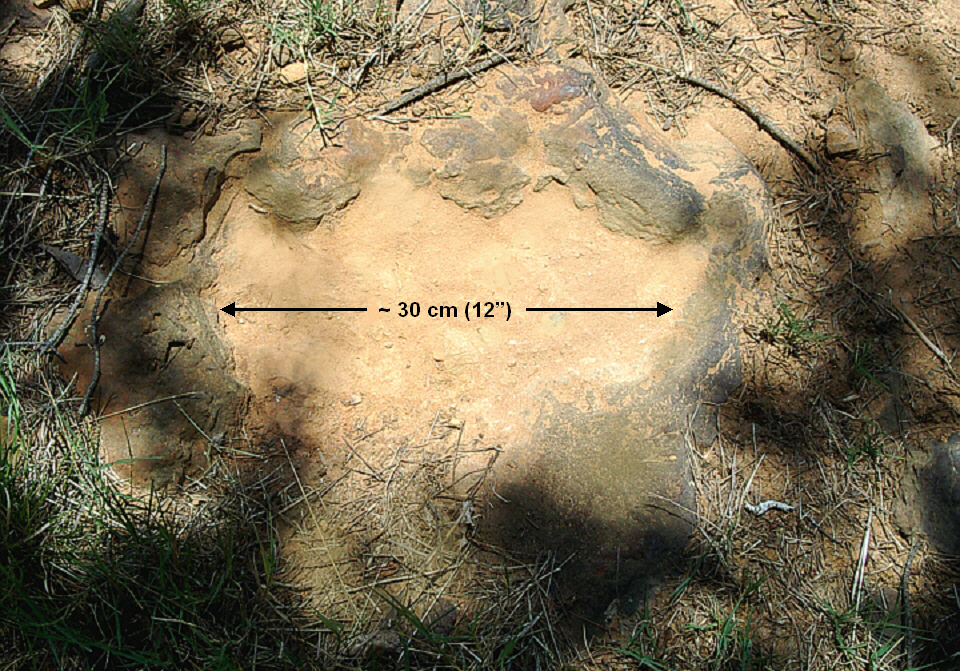NASA’s Nodosaur Footprint Verified – Perhaps with Baby Nodosaur in Tow
Not one, but two nodosaurs passed through the campus of NASA’s Goddard Space Flight Center in Greenbelt, Md., between 110 and 112 million years ago, a U.S. Geological Survey (USGS) paleontologist confirmed.
The second track, overlapping the first, looks to be a young version of the same creature, perhaps following and sniffing along after, said Rob Weems, emeritus paleontologist and stratigrapher with the USGS, from Reston, Va. “It’s definitely a track.”
He confirmed the track to be a nodosaur footprint while visiting NASA Goddard on Aug. 23 at the invitation of center officials. He also discovered the second track while clearing and excavating the stone plate that contained the first print. Nodosaurs are a type of heavily-armored plant eater, as heavy as small elephants. The name is derived from the many spikes or nodes in their armor.
“It looks to be a manus print of a much smaller dinosaur than the first one, but it looks to be the same type,” Weems said of the second track. The manus is the front foot of a quadrupedal animal, while the pes is the back foot. “If the one that came through was a female, it may have had one or more young ones following along. If you’ve seen a dog or cat walking with it’s young, they kind of sniff around and may not go in the same direction, (as the adult) but they end up in the same place.”
The tracks had to have been made around the same time, at least within the same day, said Ray Stanford, an amateur dinosaur tracker who discovered the “momma” track during the summer of 2012. The smaller track shows signs of pushing up the still-wet mud, that the larger footprint had hollowed out.
NASA Goddard facilities director Alan Binstock said the next steps will be to have the site analyzed to determine whether further excavation is called for, and to extract and preserve the existing footprints.
Monday Aug. 20, 2012
About 110 million light years away, the bright, barred spiral galaxy NGC 3259 was just forming stars in dark bands of dust and gas. Here on the part of the Earth where NASA’s Goddard Space Flight Center would eventually be built, a plant-eating dinosaur sensed predators nearby and quickened its pace, leaving a deep imprint in the Cretaceous mud.
On Friday, Aug. 17, 2012, noted dinosaur hunter Ray Stanford shared the location of that footprint with Goddard’s facility management and the Washington Post newspaper.
“This was a large, armored dinosaur,” Stanford said. “Think of it as a four-footed tank. It was quite heavy, there’s a quite a ridge or push-up here. … Subsequently the sand was bound together by iron-oxide or hematite, so it gave us a nice preservation, almost like concrete.”

Stanford, a “proud amateur dinosaur tracker” has had several papers published, including the discovery of a new species of nodosaur from a fossilized hatchling found near the University of Maryland in College Park. He previously confirmed the authenticity of this track with David Weishampel of Johns Hopkins University in Baltimore, author of the book “Dinosaurs of the East Coast.”
He had material from the same Cretaceous-era sedimentary rock dated, with help from the US Geological Survey, to approximately 110- to 112-million years old, by analyzing pollen grains sealed in the stone. The Cretaceous Period ran between 145.5 and 65.5 million years ago, and was the last period of the Mesozoic Era.
Goddard Facilities Manager Alan Binstock said the agency considers the footprint and its location “sensitive but unclassified.”
The footprint is on federal land, so improperly removing it could potentially violate three laws: the Antiquities Act, the Archaeological Resources Protection Act and the Paleontological Resources Preservation Act.
NASA officials will next consult with the State of Maryland and paleontologists to form a plan for documenting and preserving the find, Binstock said.
Stanford also identified and presented several smaller footprints – three-toed, flesh-eating therapods – to Goddard officials from the same site.
He called the location of the find “poetic.”
“Space scientists may walk along here, and they’re walking exactly where this big, bungling heavy armored dinosaur walked, maybe 110 to 112-million years ago,” Stanford said.
Read the Washington Post story:
http://www.washingtonpost.com/national/health-science/dinosaur-age-…


























